Spotting Scopes vs Binoculars: Which To Choose?
Last Updated on
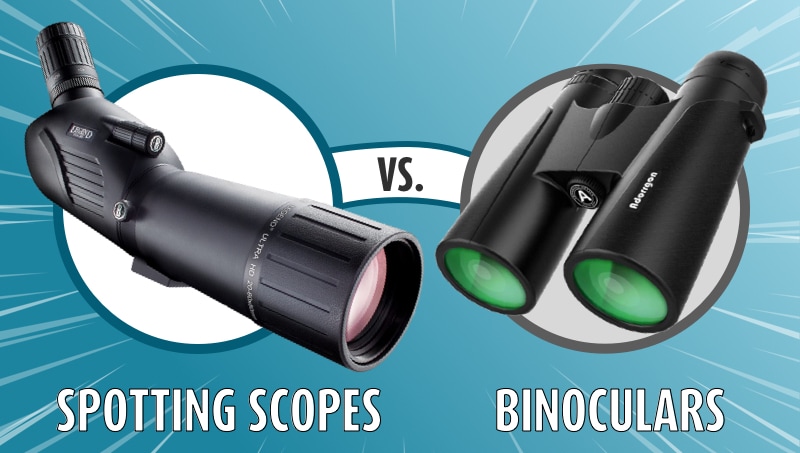
Whether you’re a hunter, target shooter, birder, nature watcher, or any other type of outdoor sportsperson, you likely need to see far-away places and things in great detail. Today, you have options for the best way to do this, but the two main choices boil down to spotting scopes and binoculars.
Both of these helpful devices will magnify far-off subjects so you can analyze them without getting close. So, what are the differences between them and when should you choose one over the other?
In this article, we’re going to go in-depth on the traits that separate these two useful tools. But before we can discuss their differences, let’s first explain each of them and make sure we’ve got a clear understanding of both spotting scopes and binoculars.
Spotting Scope Overview
Spotting scopes are essentially small, portable telescopes. But they’re not as powerful as telescopes since they’re not intended to look at the stars. Moreover, telescopes are meant for night viewing while spotting scopes have been modified to allow daytime viewing in the sunlight. Meanwhile, monoculars and spotting scopes are generally the same devices with different lens sizes and magnification power. Monoculars are the smaller and weaker of the two siblings.
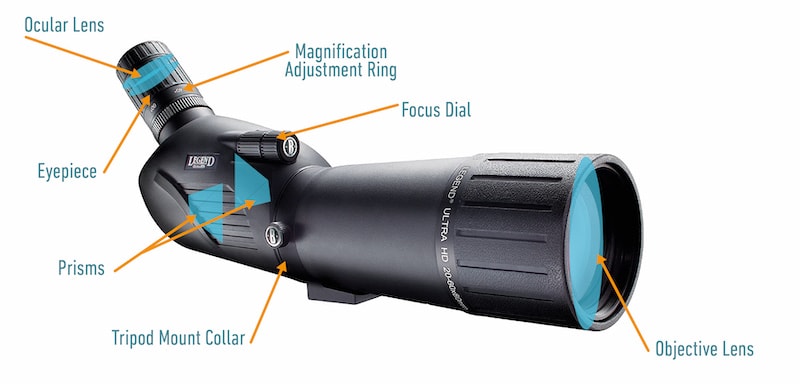
Rather than celestial objects in outer space, spotting scopes will allow you to see objects that are too far to see clearly with the naked eye, but not outside of our atmosphere. They can be held by hand for quick and convenient use or they can be mounted to a tripod or stand for shake-free viewing.
While telescopes are very fragile instruments, spotting scopes are built much tougher. They have to endure the elements and trips through the outdoors, so they’re often made water and weatherproof. They’re also light and compact enough to not be a nuisance when carried on such trips.
Applications
The usefulness of spotting scopes means they are commonly used in birding and nature watching where they allow the watcher to see animals that are far away in great detail as if they were close up. This makes it easy to observe them without alerting them to your presence and scaring them away.
Likewise, hunters employ spotting scopes for similar reasons. It allows them to spot and track prey from a distance without giving away their position and losing their target.
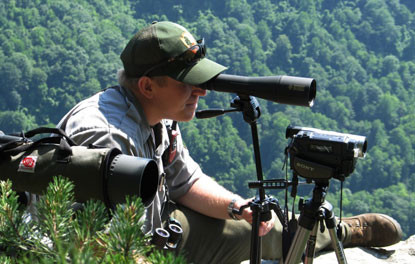
Even photographers commonly use spotting scopes. Some are even made to work with cameras, allowing for detailed close-up photographs of animals that are far away. This can be especially useful when photographing dangerous predators that you might kill you if you get too close!
Shooters, particularly long-distance shooters use spotting scopes to tell whether or not they hit the target. At ranges of 100 yards and greater, you can’t see the bullet hole from where you’re shooting and it would be a giant waste of time to walk and back forth from the target after each shot!
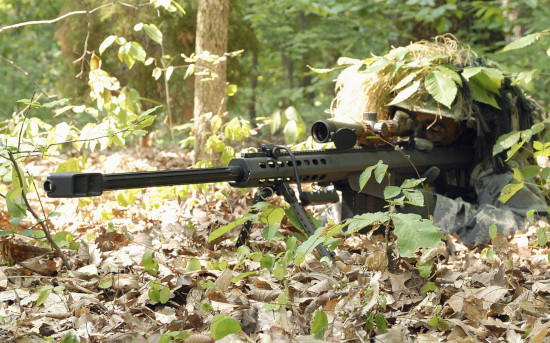
It sounds a bit more sinister, but spotting scopes are also used in surveillance. When you need to watch a target from a distance without them knowing, spotting scopes is a portable tool that’s perfect for the job.
Lens & Prism
Generally speaking, a larger objective lens will let in more light and allow for a more detailed image. This improves the image quality of the device, but there’s a caveat. Larger lenses of lower quality won’t provide the same level of image quality. So, bigger isn’t always better.
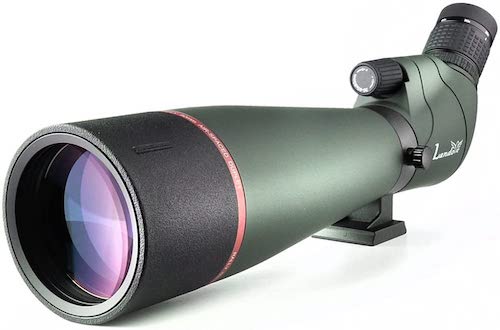
That said, if you’re comparing two lenses of the same quality, the larger lens will provide a better image. Spotting scopes tend to have rather large objective lenses, ranging from 45mm to 100mm. Most commonly though, spotting scope lenses will tend to fall in the 60mm-80mm range.
BaK-4 vs BK-7 Prism Glass: Which is Better?
Most spotting scopes use BaK-4 or BK-7 glass Porro prisms. BaK-4 is a glass designation originated by Schott AG, a renown German optical glass manufacturer. BaK stands for BaritleichKron (German for “Barium Crown”). It has a higher refractive index than BK-7 glass, meaning more light from the periphery of the field of view gets through the prisms and reaches the eyepieces. This brightens the edge of the field while leaving the middle intact.
BK-7 is generally considered “cheaper” and less desirable than BaK-4, but it’s actually better in some applications such as astrophotography.
Magnification
Magnification is the measure of how much larger your subject appears when viewed through a device. For instance, a 10x magnification means that whatever you’re viewing will appear 10 times larger through your device than through the naked eye.
Naturally, higher magnification means that you’ll see more detail on your subject. But that doesn’t mean that higher magnification is always better. Higher magnification can also mean more image shake, which results in a blurrier image.
Also, atmospheric conditions can make it impractical to view at high levels of magnification at certain times or in certain places. Dust in the air, heat waves, air currents, and more can all turn your image into a blurry mess at high levels of magnification, even with high-quality optics.
Spotting scopes most commonly range from about 15x magnification to about 60x. Above this, atmospheric conditions can make it too difficult to view during the day. But 60x magnification is a lot! That means that your subject will appear 60 times bigger or 60 times closer than when you pull the scope away from your eye.
Keep in mind, more magnification usually means a heavier instrument. For this reason, spotting scopes, though small enough to take with you in the field, can add quite a bit of weight to your pack. And the more magnification your spotting scope has, the more weight it is likely adding.
Field of View
The field of view refers to how much area you can see in the total image displayed by your device. In general, higher magnification means a smaller field of view.
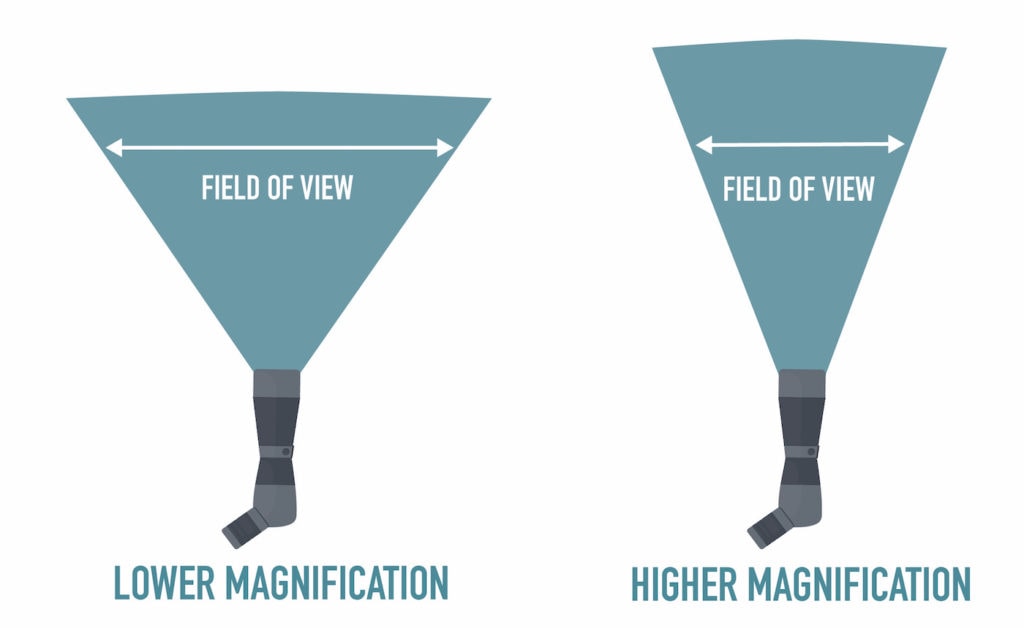
FOV, or field of view, is measured at a particular distance, most often, 1,000 yards. Most spotting scopes will have a field of view that’s between 50-150 feet at 1,000 yards. This means that you’ll see an area that’s between 50-150 feet wide when viewing through your spotting scope. But remember, you’ll see it at 15-60 times its normal size.
Pros & Cons of Spotting Scopes
- High levels of magnification up to 60x
- Large objective lenses produce high image quality
- Can be handheld or tripod-mounted
- Field of view is only 50-150 feet
- Tend to be a bit heavy
Binoculars Overview
Binoculars are, in essence, two tiny telescopes mounted together so that each of your eyes looks through one. The lenses on each side will magnify the image you see, allowing you to see as you normally would only magnified by the binocular’s lenses.
For the most part, binoculars are small, lightweight, and easily portable. Many people will even hang them around their neck with a strap to make them easy to carry and access. They’re quick to use and very simple.
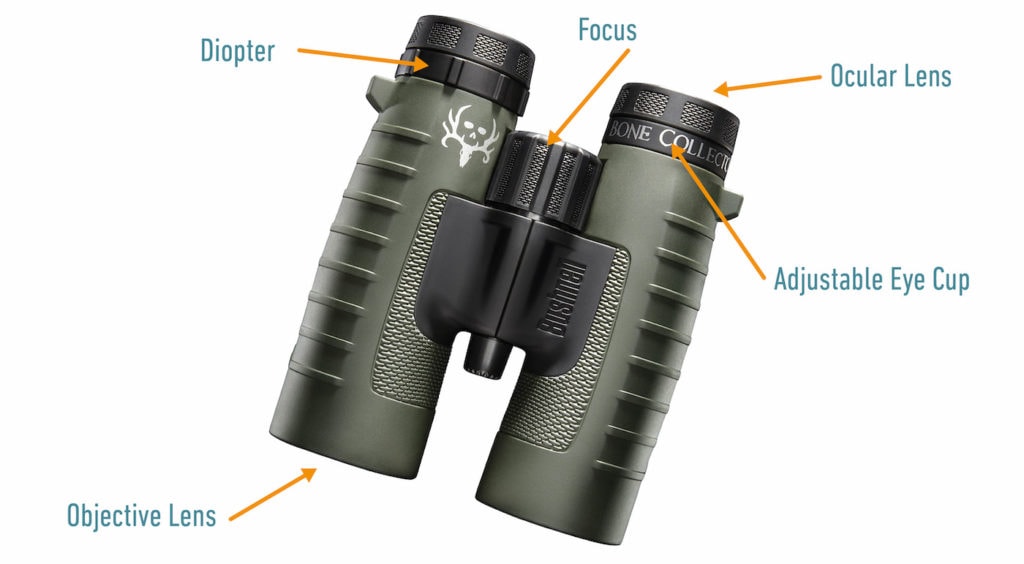
Some binoculars are made to be very powerful and are much larger than most other binoculars. Luckily, most binoculars of all sizes today can be mounted to a tripod for hands-free viewing. But the biggest benefit of binoculars is that you can easily use them by hand without the need for other tools. And you can take them way out into the wilderness without weighing yourself down.
Binoculars are built to handle adverse outdoor conditions. They’re built tough and are often fog-proof, waterproof, weather-proof, and impact-resistant in case they get dropped.
Applications
Binoculars are used by many people in many activities, though the list looks pretty similar to that of spotting scopes. Hunters will use binoculars to spot game and help with tracking. Wildlife watchers and birders will use binoculars for the same reason.
People watching live sporting events and concerts can often be found employing binoculars to help see better when they’re in the farther seats.
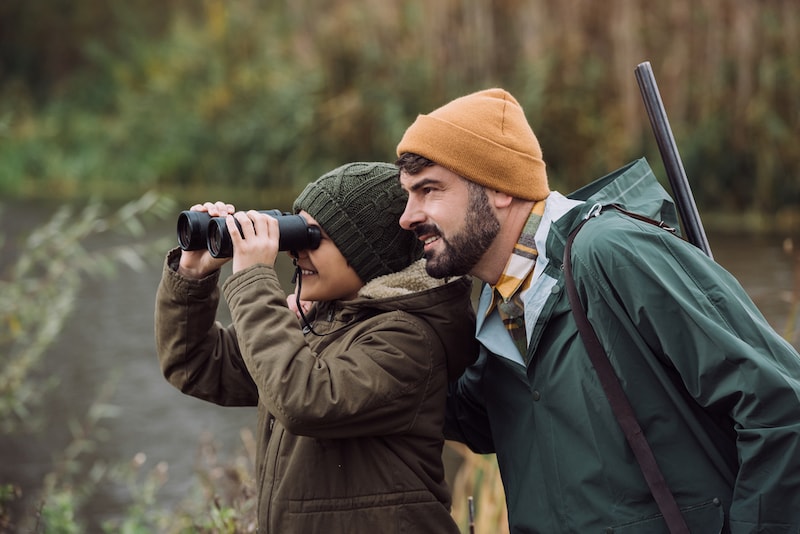
Hikers and navigators use binoculars to help determine their next location and how to get there.
Lenses & Prisms
Binoculars can have a range of lens sizes. Compact binoculars that are made small for easy portability will have lenses as small as 25 millimeters. Larger, all-purpose binoculars that you’ll see most often are between 40-50 millimeters.

Some specialty binoculars have lenses as large as 100mm, but they’re for astronomy and aren’t practical for day viewing or most outdoor sports and hobbies.
There are three main types of binocular: Porro prism, Roof prism, and Galilean:
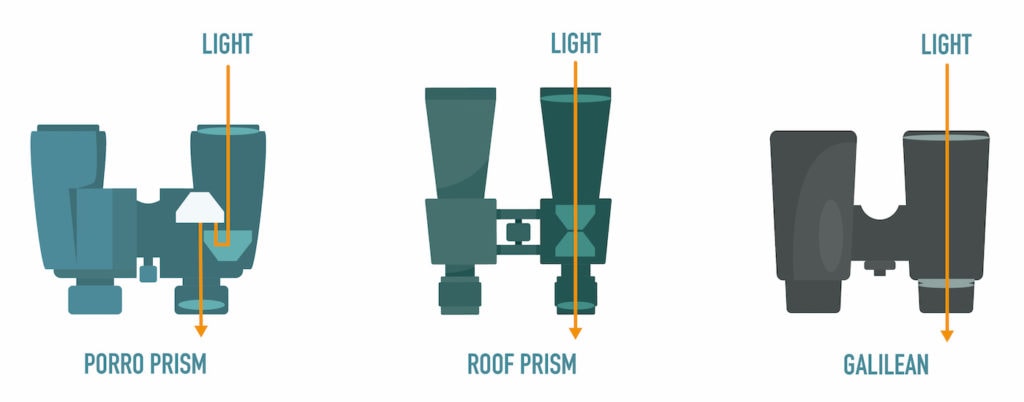
A Quick Look at Binocular Types
Porro Prism
The Porro prism optical system was developed by Italian optician Ignazio Porro in 1854, and later developed by other binocular makers such as Carl Zeiss in the 1890s. Porro prisms have a Z-shaped orientation that provide more depth and clarity. However, they’re very fragile and often need a realignment called collimation.
Roof Prism
Roof prisms are used in narrow and compact binoculars, primarily for reducing light transmission, which improves magnification. These binoculars are favored for their streamlined design, waterproofing, and durability.
Galilean
The most primitive of the three types, Galilean optics use a convex objective lens and a concave eyepiece. Most modern binoculars eschew the Galilean model of old, with the exception of binoculars for kids and opera glasses. They are typically low magnification and have a poor field of view.
Magnification
Binoculars cover a wide range of magnifications, but they’re all on the lower end of the scale. You’ll rarely see standard binoculars that have more than 12x magnification. Most common in all-purpose binoculars are 4x-10x magnification levels.
Remember, higher levels of magnification mean larger devices. A set of binoculars with 12x magnification will usually be much larger than a pair with 4x magnification. So if you want a more compact set that’s easier to carry, then you’ll probably have to settle for a set with lower magnification.
Field of View
Binoculars really shine when it comes to field of view. As a general rule, when magnification increases, field of view decreases. But binoculars don’t have super high levels of magnification, so they often have a pretty wide field of view.

In regards to high-end binoculars, most of them will sport a field of view between 300 feet and 450 feet at 1,000 yards. This means you’ll be seeing a magnified area that’s about 300-450 wide at 1,000 yards distance from where you’re viewing.
Pros & Cons of Binoculars
- Small and easily portable
- Built to withstand adverse outdoor conditions
- Very wide field of view
- Magnification tops out around 12x
Differences Between Spotting Scopes and Binoculars
Applications
Realistically, both of these tools are in most of the same sports, hobbies, professions, and activities. But binoculars have a bit of a wider-reaching base compared to the more specialized use of spotting scopes.
Because everyone knows about binoculars and they’re easily accessible, they tend to be the go-to tool. Also, many people and activities are better suited to smaller, more compact tools rather than large, heavier tools with overpowered magnification for that activity.

But many activities are well-suited to both tools. In fact, many hunters, birders, nature-watchers, photographers, and more will use both of them. Because they each have different strengths, each one is more preferable under certain circumstances. Rather than settle for only the strengths of one, many people will just take both.
Lens & Prism
Remember, when comparing two lenses of the same quality, the larger objective lens will provide a higher image quality. But it will also make for a much larger tool that’s harder to carry.
- Spotting scopes have larger objective lenses. They are meant for viewing things at longer distances than binoculars, so they need the extra size to make sure the image is detailed and clear. With 80-millimeter lenses often being found on these tools, they can become quite large. But the image quality is excellent, even at very long distances.
- Binoculars usually have lenses under 50 millimeters. This makes them more compact and portable, but it also means they don’t have the same image quality as spotting scopes. Often, they don’t need to. Because they have lower levels of magnification, the smaller lenses will do just fine, but you won’t see as far or as detailed with binoculars.
Magnification
- Binoculars usually range from 1x magnification to 12x.
- Spotting scopes pick up from there with magnification levels that most commonly fall between 15x-60x. Obviously, this means that spotting scopes can show you more detail and magnify subjects at much farther distances for your viewing pleasure. But everything has a tradeoff. In this case, it results in spotting scopes having a much smaller field of view.
User Tip
Binoculars can’t see as far, but they also don’t shake as much.
Trying to view something at 30x magnification through a spotting scope while holding it by hand can be an incredibly difficult task. Most often, they’re mounted to tripods. But binoculars can easily be used by hand, even though they can also be mounted to tripods for comfort.
Field of View
Field of view is the measure of how wide of an area you can see at 1,000 yards. Spotting scopes tend to have FOVs between 50-150 feet. But binoculars have FOVs that range from 300-450 feet.
- Spotting scopes are great for when you’ve already located your target and they’re not moving much and you want to keep an eye on them. Because you have a very small field of view with a spotting scope, tiny movements can make big changes in what you see, causing you to easily lose a target with just a small touch of the instrument.
- With a much larger field of view, binoculars make it easier to locate a target that you saw with your naked eyes. Of course, the tradeoff is that you won’t see them in as great of detail and you’ll have a limited distance of usability.
Price
Though you can find some entry-level spotting scopes in the $500 range, most of the professional-quality models are much more expensive. You can expect to spend at least $1,000 on a high-quality spotting scope, though prices as high as $2,000 and above for the high-end models are not uncommon.This is another reason why binoculars tend to be much more popular. You can easily find many good-quality sets of binoculars for under $100. Granted, some pairs can easily reach $2,000 and beyond, but you can find tons of models populating the $50-$300 price range. And for $300, you can get a great quality set of binoculars that will serve you very well.
When to Use a Spotting Scope
Spotting scopes are best when you need to see something that’s really far away. With magnification levels that commonly reach 60x, these can make it possible to see things from a great distance in high levels of detail.
But because of that magnification, they’re best used on a tripod so they can be held steady. You’ll introduce a lot of image shake when holding a spotting scope by hand. So they’re best when you tend to set up in an area for a while rather than staying on the move.
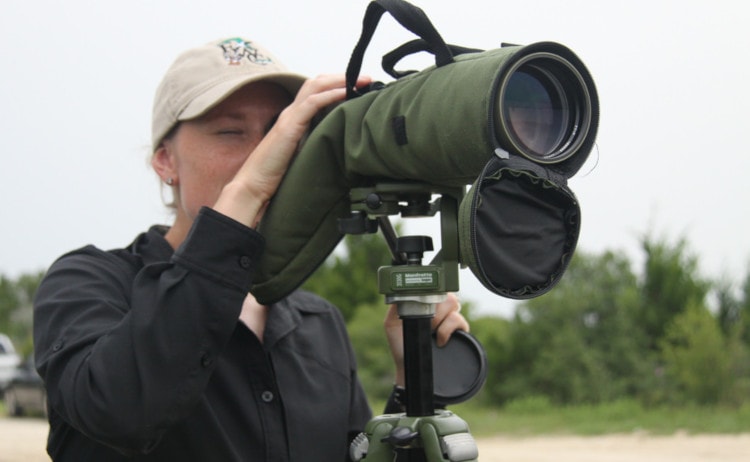
They’re also best if you’re not planning to trek too far. Because of their weight and size, binoculars often make a better choice when you’re trying to cover a lot of ground. That said, if you need to make a lot of distance and you still need very high levels of magnification, then spotting scopes are often still the best tools for the job.
This is perfect for any application where you want to observe without being seen. Hunters, wildlife watchers, birders, anyone performing surveillance, and plenty more will find spotting scopes to be an invaluable tool.
When to Use Binoculars
Binoculars have tons of uses. Because they’re small, easily accessible, and easily portable, they make great carry-along tools for many applications.
These are the best choice when you need something small and lightweight. They’re also best for viewing subjects that aren’t too distant. Because they usually have magnification levels of 12x or less, binoculars aren’t the best choice for very long-distance viewing.
Because of their wide field of view, binoculars are great when you need to watch moving targets. This makes them perfect for hunting, watching sports games or concerts, and nature watching. But they’re limited by their range, so they can’t help if your target is too far.
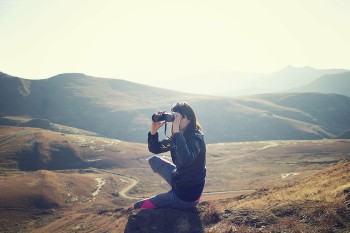
In many cases, binoculars can be used to spot a target before magnifying it with a spotting scope for greater detail. Of course, this comes with a lot of extra expense and carrying weight, so it’s not for everyone, though it can open up a lot of viewing possibilities.
Most of the time, binoculars are built tougher than spotting scopes, so they’re best for rough environments and adverse weather conditions. Spotting scopes can still be built with great features like water-resistance and fog-proof lenses, but binoculars tend to be more durable all the way around.
Which is Right For You?
Now you know the differences between spotting scopes and binoculars. Though they both have many similar uses, their characteristics make them each more preferable at different times.
If you have a lower budget to work with, you’ll probably want to stick with binoculars. You can get a high-quality pair for less than an entry-level spotting scope. Binoculars are also smaller and more portable, making it easier to practice your craft anywhere. Plus, their wider FOVs make it easier to find targets since you see more of an area with binoculars.
But spotting scopes still win in the distance department. If you need to see far-off subjects in high levels of detail, then you’ll want a spotting scope, They have magnification levels up to 60x with large objective lenses for high-detail viewing at long distances. But they’re bigger, less portable, and far more expensive.
If budget is no factor and you don’t have to carry them far or you don’t mind the extra weight, you might find it useful to employ both. This allows you to use the binoculars to spot and locate your targets and then switch to the spotting scope for the most detailed viewing.
•Indoor Sports Photography – 7 Tips to Get the Best Shots
Featured Image Credit: A group of men stand birdwatching, Wikipedia, Public Domain Image
About the Author Robert Sparks
Robert’s obsession with all things optical started early in life, when his optician father would bring home prototypes for Robert to play with. Nowadays, Robert is dedicated to helping others find the right optics for their needs. His hobbies include astronomy, astrophysics, and model building. Originally from Newark, NJ, he resides in Santa Fe, New Mexico, where the nighttime skies are filled with glittering stars.
Related Articles:
How to Collimate Binoculars: 9 Expert Tips
How to Clean a Refractor Telescope: Step-by-Step Guide
How to Clean a Telescope Eyepiece: Step-by-Step Guide
How to Clean a Rifle Scope: 8 Expert Tips
Monocular vs Telescope: Differences Explained (With Pictures)
What Is a Monocular Used For? 8 Common Functions
How to Clean a Telescope Mirror: 8 Expert Tips
Brightfield vs Phase Contrast Microscopy: The Differences Explained
